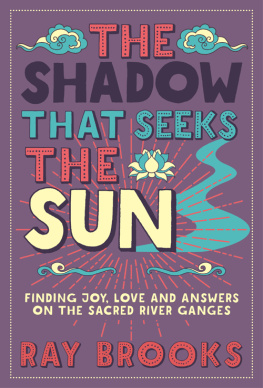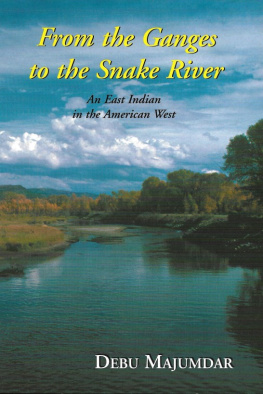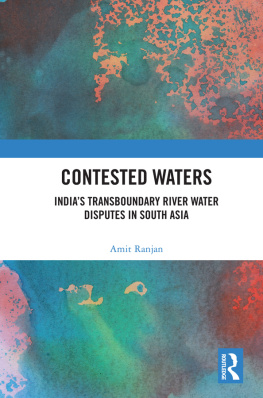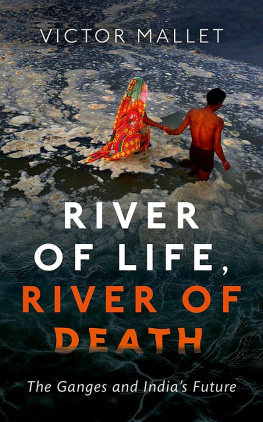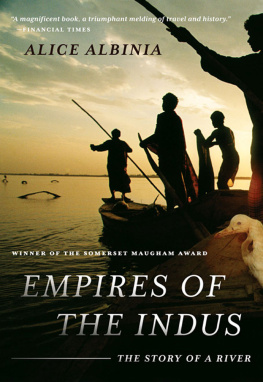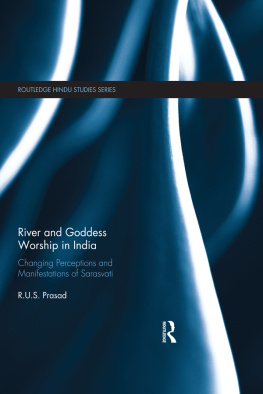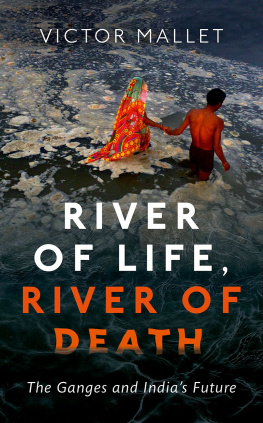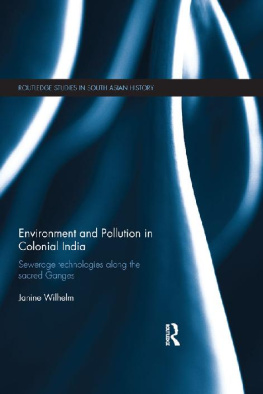GANGES

SUDIPTA SEN
GANGES
The Many Pasts of an Indian River
Yale UNIVERSITY PRESS
NEW HAVEN AND LONDON
Copyright 2019 by Yale University. All rights reserved.
This book may not be reproduced, in whole or in part, including illustrations, in any form (beyond that copying permitted by Sections 107 and 108 of the U.S. Copyright Law and except by reviewers for the public press), without written permission from the publishers.
Yale University Press books may be purchased in quantity for educational, business, or promotional use. For information, please e-mail (U.K. office).
Designed by Nancy Ovedovitz and set in Meridien LT and Brandon Grotesque type by Newgen.
Printed in the United States of America.
Library of Congress Control Number: 2018953983
ISBN 978-0-300-11916-9 (hardcover : alk. paper)
A catalogue record for this book is available from the British Library.
This paper meets the requirements of ANSI/NISO Z39.48-1992 (Permanence of Paper).
10 9 8 7 6 5 4 3 2 1
: Gulls alighting on the Ganges at Varanasi.
Photograph by Debal Sen.
In memory of my maternal
grandfather, Sisir Mallik,
who taught us always to think of
others first
CONTENTS
PREFACE
I visited the upper reaches of the Ganges for the first time as a child in 1968. I distinctly remember its vivid aquatint blue-green ripples near the swinging suspension bridge at Lakshman Jhula. I was told that the two valiant brothers from the epic Ramayana had once crossed the river at that place. I remember being afraid of the beggars and lepers along its sides who solicited alms from travelers and pilgrims with their lusty cries and dramatic gesticulations. I also remember crossing the river on a crowded and unsteady ferry boat near Hrishikesh, where I could see the fish swimming in dark emerald shoals and swarming to the sides of the boat without fear as pilgrims scattered puffed rice over the water. I was familiar with the industrial waterscape of the Hugli River in Calcutta, now Kolkata, the city where I was born and brought up. The Ganges that I saw near the foothills of the Himalayas was different. Magical. Now those quiet and reclusive pilgrim towns are gone, changed beyond recognition. The river is not the same as I remember it.
Such recollection is hardly a reliable starting point for a history as large and overwhelming as this. But it is the nature of the Ganges and its presence in the minds and imagination of the people of my subcontinent that make it difficult not to think about the past without a sense of loss, no matter how indistinct or disarticulated. There is no getting away from the fact that Indias great river is in trouble, suffocated by dams, overcrowded, and polluted.
This book is not about global warming or the debates surrounding the Anthropocene, but the discerning reader will detect the weight of such concerns and anxieties throughout these pages. I started writing this book twelve years ago when disputes about the future of our planet had not quite acquired the same stridency as they have today. It would be remiss not to acknowledge the fact that the fear of climate change has occupied my thoughts about the connection of the past and the future of the river as I have traveled to various points along its course to get a better sense of the terrain that I was writing about. I have followed the course of the river over the last two decades at Rajmahal, Bhagalpur, and Munger in the corridor between Bengal and Bihar; between Sasaram, Banaras, and Allahabad along the vestiges of the old Grand Trunk Road; and between the pilgrimages of Rishikesh and Gangotri in the mountains. I have crossed over the glacial cave of Gaumukh, where the river emerges, to the high-Himalayan glades of Tapovan at the base of the mighty Shivling peak. I have visited the eerie mangrove forests and the salty flats of its extensive delta.
A book like this would not have been possible without a multitude of friends, well-wishers, and extended family who have inquired, encouraged, cajoled, and needled me to get on with the project, urging me to see the end while it became larger, more daunting, and more unruly with each passing year. I will not be able to thank them all in the confines of this printed space, but I would like to remember friends who braved both instinct and logic to accompany me in many of my impulsive expeditions along the Ganges: Pradeep Gooptu for some memorable trips to Banaras, Chunar, and Triveni; Tapati and Shrimoy Roychaudhuri for their company at Munger, Bhagalpur, Rajmahal, and Gaumukh; and Sharmadip Basu for making it possible for us to trek to the magnificent glacial valley of Tapovan. I thank my friend Litan Dhar for taking me to my first tentative dip at the confluence of Prayag back in 1991. I am also grateful to Shikha Mukherjee for arranging trips to the mangroves and islands of the Sunderbans. Finally, I thank Debal Sen, a mentor in matters of aesthetic and spiritual abandon, for his nonpareil camerawork that graces the frontispiece and many of the following pages, and especially for his company at the ghats of Banaras and for one unforgettable afternoon spent with the ancient trees near the ruins of the Mulagandhakuti Vihara that are the sentinels of Sarnath. Among people who have had to listen to my long discourses about this project over the years, I must mention colleagues that I worked with at the Davis Humanities Institute, James Smith, Beth Freeman, Simon Sadler, Julia Simon, and Tobias Menely; and my departmental colleagues Ali Anooshahr, Baki Tezcan, Omnia El Shakry, Louis Warren, and Alan Taylor. To this list I must add Faisal Devji, Ramendra Sarkar, Gautam Bhadra, Daud Ali, Nita Kumar, Kevin Grant, Lisa Trivedi, Nadine Berardi, Kathryn Babayan, Jayanta Sengupta, Panchali Sen, Osmund Bopearachchi, Bishnupriya Basak, Carola Erika Lorea, Jo Guldi, Shakeel Hossain, Martha Selby, Padma Kaimal, Rick and Cathy Asher, Vandana Sinha, and my ever-supportive colleague Nicole Ranganath.
I have received many helpful comments and feedback at the conferences and talks where I have presented chapters or sections of this book. Of these I would like to mention in particular the addresses I delivered for the conferences Land and Water: A Long-Term Perspective (September 2015) organized by the Watson Institute, Brown University, and Sharpening the Edges: Instating State and Power in Indian Ocean History (August 2015), a workshop funded by the Andrew W. Mellon Foundation and organized by the International Institute for Asian Studies, Leiden. Other venues where I have presented parts of this book include Sacramento State University; Victoria Memorial Hall, Kolkata; the Instituto Italiano di Studi Orientali, La Sapienza University, Rome; the American Folklore Society; the American Historical Association; the Marian Miner Cook Athenaeum Speakers Series, Claremont McKenna College; and Hamilton College, New York.
Thanks are also due to Neel Amin for tracking down the sources and copyrights of images, to Molly Roy for her terrific work on the maps that are an integral part of this book, to Jaya Chatterjee for her patience and advice through the last and the most difficult stages of bringing the book to a close, and to my compadre and partner-in-crime for all sorts of intellectual and aesthetic transgressions, novelist Stephen Barnett, whose editorial wizardry is hidden in plain sight throughout the book. Lastly, I must acknowledge and atone for the endless frustration I must have put my familyL, D, and Mthrough in my years of writing the Ganges book.
GANGES
INTRODUCTION
Our story begins with the basin of the Kali Gandaki River, which flows from Nepal into India through the desolate Ladakh Range defile over a bed that is 5,000 feet high, joining at last the River Ganges above Saran in the northern Indian plains. Along the course of this river lie some of the oldest trails frequented by yak caravans, Buddhist monks, and salt traders since antiquity. In a distant geological epoch the Kali Gandaki used to flow all the way from Tibet. The river is much older than the Himalayas, which make up one of the youngest mountain systems in the world. Geologists have been fascinated by the Kali Gandaki and its tributaries because it is the only river that has retained its path through the Himalayan massif. In a geological process known as antecedence, it has cut its path at a pace faster than the rise of the mountains, resulting in one of the worlds deepest and most stunning gorges, lying between the Dhaulagiri and Annapurna peaks.
Next page

